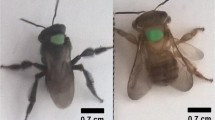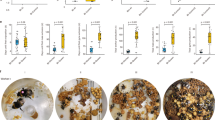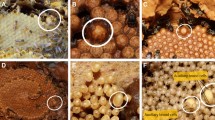Abstract
Little is known about the biology and life cycle of the Australian stingless bee, Austroplebeia australis (Friese). The ontogenic times for developing offspring, as well as the longevity of adults, drive the overall life cycle of a social colony. The developmental times for brood within stingless bee species which build cluster-type nests, such as A. australis, are as yet unreported. A technique was developed whereby ‘donor’ brood cells were separated from the main brood cluster and ‘grafted’ into hive annexes, allowing workers from within the colony to access the brood ‘grafts’ for hygiene and maintenance activities, whilst enabling observation of developing brood. The mean ontogenic time for A. australis workers, maintained at ~27 °C, was 55 days, which is similar to that reported for other stingless bees. The maximum longevity of A. australis was determined by marking cohorts of worker bees within five colonies. Workers within all colonies demonstrated extended longevity, with an overall maximum longevity of 161 days, with the oldest bee living for 240 days. Extended longevity may result from evolutionary adaptations to the floral resource scarcity, which is regularly experienced in semi-arid, inland Australia, the natural habitat of A. australis.


Similar content being viewed by others
References
Amdam G.V. and Omholt S.W. 2002. The regulatory anatomy of honeybee lifespan. J. Theor. Biol. 216: 209-228
Australian Bureau of Meteorology 2012. Climate statistics for Australian locations. Available at http://reg.bom.gov.au/climate/data/index.shtml. Retrieved 4 January 2012
Bego L.R. 1983. On some aspects of bionomics in Melipona bicolor bicolor Lepeletier (Hymenoptera: Apidae: Meliponinae). Rev. Bras. Entomol. 27: 211-224
Biesmeijer J.C. and Tóth E. 1998. Individual foraging, activity level and longevity in the stingless bee Melipona beecheii in Costa Rica (Hymenoptera, Apidae, Meliponinae). Insect. Soc. 45: 427-443
Brys K., Vanfleteren J.R. and Braeckman B.P. 2007. Testing the rate-of-living/oxidative damage theory of aging in the nematode model Caenorhabditis elegans. Exp. Gerontol. 42: 845-851
Camargo J.M.F. and Pedro S.R.M. 2012. Meliponini Lepeletier, 1836. In: Catalogue of Bees (Hymenoptera, Apoidea) in the Neotropical Region (Moure J.S., Urban D. and Melo G.A.R., Eds). online version. Available at http://www.moure.cria.org.br/catalogue. Retrieved 19 January 2012
Carey J.R. 2001a. Insect biodemography. Annu. Rev. Entomol. 46: 79-110
Carey J.R. 2001b. Demographic mechanisms for the evolution of long life in social insects. Exp. Gerontol. 36: 713-722
Cartar R.V. 1992. Morphological senescence and longevity: an experiment relating wing wear and life span in foraging wild bumble bees. J. Anim. Ecol. 61: 225-231
Climatemps.com 2012. Padang, Sumatra. Available at http://www.sumatra.climatemps.com/. Retrieved 13 November 2012
Dollin A. 2010a. How to recognise the different types of Australian stingless bees. Native Bees of Australia 4: 1-13
Dollin A. 2010b. Introduction to Australian native bees. Native Bees of Australia 1: 1-10
Drumond P.M., Zucchi R. and Oldroyd B.P. 2000. Description of the cell provisioning and oviposition process of seven species of Plebeia Schwarz (Apidae, Meliponini), with notes on their phylogeny and taxonomy. Insect. Soc. 47: 99-112
Engels W., Rosenkranz P. and Engels E. 1995. Thermoregulation in the nest of the Neotropical stingless bee Scaptotrigona postica and a hypothesis on the evolution of temperature homeostasis in highly eusocial bees. Stud. Neotrop. Fauna E 30: 193-205
Fukuda H. and Sakagami S.F. 1968. Worker brood survival in honeybees. Res. Popul. Ecol. (Kyoto) 10: 31-39
Giannini K.M. 1997. Labor division in Melipona compressipes fasciculata Smith (Hymenoptera: Apidae: Meliponinae). An. Soc. Entomol. Bras. 26: 153-162
Grosso A.F. and Bego L.R. 2002. Labor division, average life span, survival curve, and nest architecture of Tetragonisca angustula angustula (Hymenoptera, Apinae, Meliponini). Sociobiology 40: 615-638
Halcroft M.T. 2012. Investigations into the biology, behaviour and phylogeny of a potential crop pollinator: the Australian stingless bee, Austroplebeia australis. PhD Dissertation, University of Western Sydney
Halcroft M.T., Spooner-Hart R. and Neumann P. 2008. A non-invasive and non-destructive method for observing in-hive behaviour of the Australian stingless bee, Austroplebeia australis. J. Apic. Res. 47: 82-83
Hartfelder K., Makert G.R., Judice C.C., Pereira G.A.G., Santana W.C., Dallacqua R. and Bitondi M.M.G. 2006. Physiological and genetic mechanisms underlying caste development, reproduction and division of labor in stingless bees. Apidologie 37: 144-163
Haydak M.H. 1970. Honey bee nutrition. Annu. Rev. Entomol. 15: 143-156
Himmer A. 1927. Ein Beitrage zur Kenntnis des Wärmehaushalts im Nestbau sozialer Hautflüger. Z. Vergl. Physiol. 5: 375-389
Howe R.W. 1967. Temperature effects on embryonic development in insects. Annu. Rev. Entomol. 12: 5-42
Jay S.C. 1959. Factors affecting the laboratory rearing of honeybee larvae (Apis mellifera L.), M.Sc. dissertation, Ontario Agricultural College of the University of Toronto
Jay S.C. 1963. The development of honeybees in their cells. J. Apic. Res. 2: 117-134
Kerr W.E. 1950. Genetic determination of castes in the genus Melipona. Genetics 35: 143-152
Kerr W.E. and Maule V. 1964. Geographic distribution of stingless bees and its implications (Hymenoptera: Apidae). J. N.Y. Entomol. Soc. 72: 2-18
Mardan M. and Kevan P.G. 2002. Critical temperatures for survival of brood and adult workers of the giant honeybee, Apis dorsata (Hymenoptera: Apidae). Apidologie 33: 295-301
Maurizio A. 1950. The influence of pollen feeding and brood rearing on the length of life and physiological condition of the honeybee. Bee World 31: 9-12
Michener C.D. 1961. Observations on the nests and behavior of Trigona in Australia and New Guinea (Hymenoptera, Apidae). Am. Mus. Novit. 2026: 1-46
Michener C.D. 1974. TheSocial Behaviour of the Bees: A Comparative Study. Harvard University Press, Cambridge
Michener C.D. 2000. Bees of the World, 2nd ed. Johns Hopkins University Press, Baltimore, USA
Moo-Valle H., Quezada-Euán J.J.G., Canto-Martín J. and Gonzalez-Acereto J.A. 2004. Caste ontogeny and the distribution of reproductive cells on the combs of Melipona beecheii (Apidae: Meliponini). Apidologie 35: 587-594
Moritz R.F.A. and Southwick E.E. 1992. Bees as Superorganisms: An Evolutionary Reality. Springer-Verlag, Berlin, Germany
Moure J.S. 1961. A preliminary supra-specific classification of the old world Meliponine bees (Hymenoptera, Apoidea). Studia Entomol. 4: 181-242
O’Donnell S. and Jeanne R.L. 1995. Implications of senescence patterns for the evolution of age polyethism in eusocial insects. Behav. Ecol. 6: 269-273
Omholt S.W. and Amdam G.V. 2004. Epigenetic regulation of aging in honeybee workers. Sci. Aging Knowledge Envir. 2004: (26) pe28
Page R.E. and Peng C.Y.-S. 2001. Aging and development in social insects with emphasis on the honey bee, Apis mellifera L. Exp. Gerontol. 36: 695-711
Roubik D.W. 1989. Ecology and Natural History of Tropical Bees. Cambridge Tropical Biology Series. Cambridge University Press, Cambridge
Roubik D.W. and Peralta F.J.A. 1983. Thermodynamics in nests of two Melipona species in Brasil. Acta Amazonica 13: 453-466
Sakagami S.F. 1982. Stingless bees. In: Social Insects, Vol. 3 (Hermann H.R., Ed) Academic Press, New York. pp 362-421
Sakagami S.F. and Fukuda H. 1968. Life tables for worker honeybees. Res. Popul. Ecol. (Kyoto) 10: 127-139
Sakagami S.F. and Zucchi R. 1963. The oviposition process in a stingless bee, Trigona (Scaptotrigona) postica Latreille. Studia Entomol., Petrópolis 6: 497-510
Salmah S., Inoue T., Mardius P. and Sakagami S.F. 1987. Incubation period and post-emergence pigmentation in the Sumatran stingless bee, Trigona (Trigonella) moorei. Jap. J. Entomol. 55: 383-390
Salmah S., Inoue T. and Sakagami S.F. 1996. Incubation period and post-emergence pigmentation in the Sumatran stingless bee Trigona (Heterotrigona) itama (Apidae, Meliponinae). Jap. J. Entomol. 64: 401-411
Simões D. and Bego L.R. 1991. Division of labor, average life span and life table in Nannotrigona (Scaptotrigona) postica Latreille (Hymenoptera, Apidae, Meliponinae). Naturalia, São Paulo 16: 81-97
Sommeijer M.J. 1984. Distribution of labour among workers of Melipona favosa F. age-polyethism and worker oviposition. Insect. Soc. 31: 171-184
Terada Y., Garofalo C.A. and Sakagami S.F. 1975. Age-survival curves for workers of two eusocial bees (Apis mellifera and Plebeia droryana) in a subtropical climate, with notes on worker polyethism in P. droryana. J. Apic. Res. 14: 161-170
van Benthem F.D.J., Imperatriz-Fonseca V.L. and Velthuis H.H.W. 1995. Biology of the stingless bee Plebeia remota (Holmberg): observations and evolutionary implications. Insect. Soc. 42: 71-87
Wille A. 1983. Biology of the stingless bees. Annu. Rev. Entomol. 28: 41-64
Wilson E.O. 1971. The Insect Societies. Harvard University Press, Cambridge
Winston M.L. 1991. The Biology of the Honey Bee. Harvard University Press, Cambridge
Wittmann D., Bego L.R., Zucchi R. and Sakagami S.F. 1991. Oviposition behavior and related aspects of the stingless bees XIV. Plebeia (Mourella) caerulea, with comparative notes on the evolution of the oviposition patterns (Apidae, Meliponinae). Jap. J. Entomol. 59: 793-80
Author information
Authors and Affiliations
Corresponding author
Rights and permissions
About this article
Cite this article
Halcroft, M., Haigh, A.M. & Spooner-Hart, R. Ontogenic time and worker longevity in the Australian stingless bee, Austroplebeia australis . Insect. Soc. 60, 259–264 (2013). https://doi.org/10.1007/s00040-013-0291-9
Received:
Revised:
Accepted:
Published:
Issue Date:
DOI: https://doi.org/10.1007/s00040-013-0291-9




